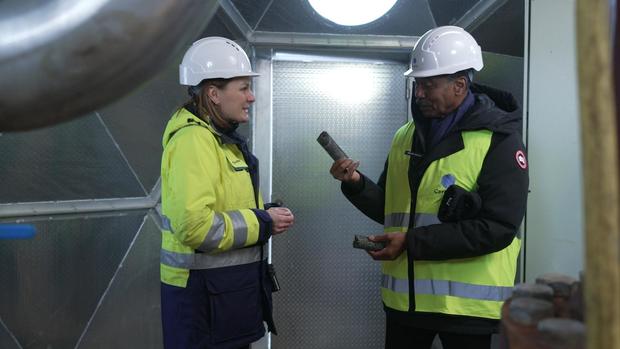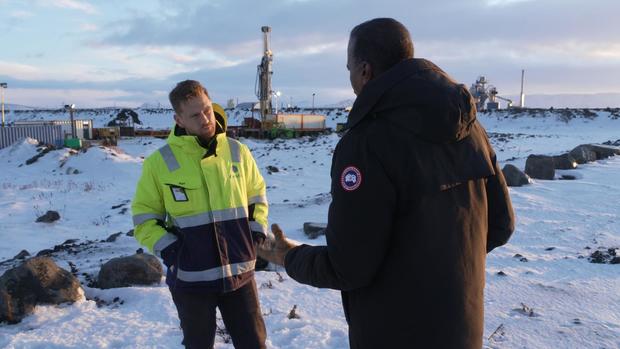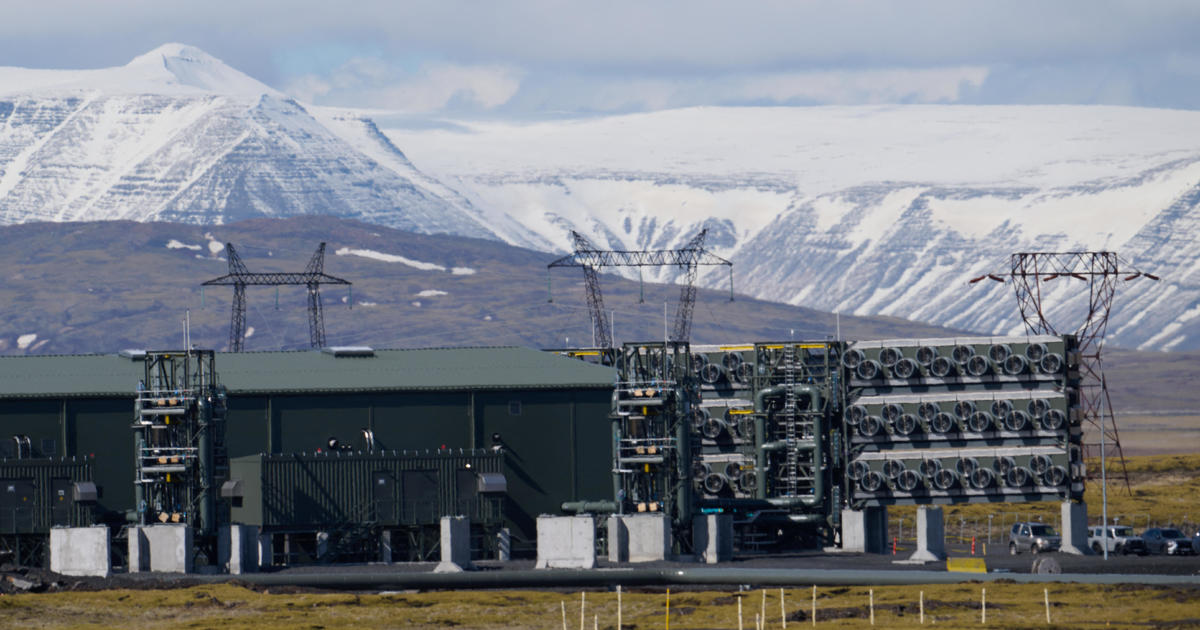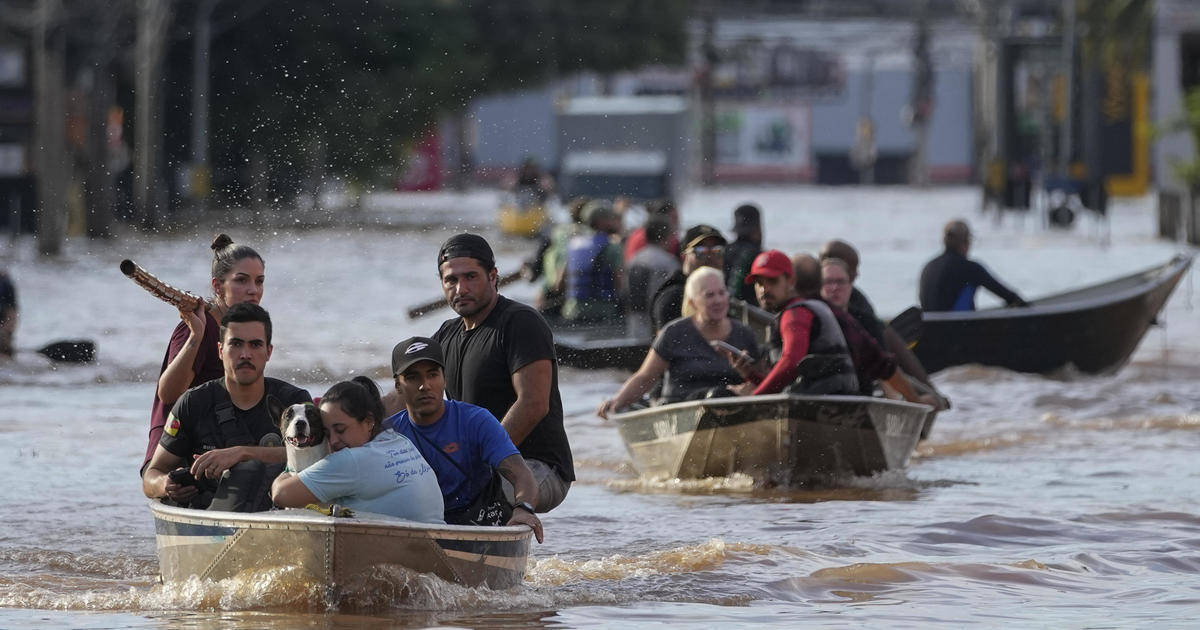Climate advocates question if direct air capture can be scaled fast enough to slow climate change
Last month the world's top climate scientists delivered a sobering warning. Their mammoth report to the UN boiled down to one message: act now, before the climate breakdown becomes unstoppable. The report says extreme weather has forced millions of people from their homes and devastated food supplies. Oil and gas emissions are at a record high. The UN report calls for drastic cuts in fossil fuels. But if our old technologies got us into this mess, can new ones get us out? Among politicians, corporations and billionaires, one new technology is gaining traction. It's called direct air capture that vacuums carbon dioxide out of thin air and locks it away underground. Sound like science fiction? We thought so too until we went to Iceland to see the world's first commercial Direct Air Capture plant in operation.
Here on a frigid plain near the Arctic Circle, worries about an overheating planet seem far away. Yet tiny Iceland has put itself on the front line, with a new kind of machine that will fight climate change by sucking carbon dioxide out of the air. This is ORCA — the first commercial direct air capture plant on earth.
Bill Whitaker: What are these fans? How does this work?
Carlos Haertel: Here you see the back side of these collectors where the air is being pulled through the system by aid of these fans.
Carlos Haertel is chief technology officer for Climeworks, the Swiss company that built ORCA. He told us, as the fans draw air in, the carbon dioxide is trapped by a special filter inside these giant collectors—each the size of a shipping container. The captured CO2 is then siphoned off to storage tanks. We had to shout over the powerful fans as a bitter wind whipped around us.
Bill Whitaker: So you didn't come for this wonderful weather?
Carlos Haertel: No, we did not. We knew that the winters were harsh, but it's a good real-life test as well for the plant.
Bill Whitaker: What you're describing almost sounds like science fiction, but what you're saying is that we can actually do this?
Carolos Haertel: People never doubted the fundamental physics or chemistry of it. But realizing it under real-life conditions is a whole different matter. And that's what this system shows. It can be done.
Climeworks is now building a new plant in Iceland 10 times the size of ORCA that will look like this—a modular design that Haertel told us can be easily assembled. But capturing the CO2 is only half of the story.
Sandra Osk: So this is where the magic happens.
The second half starts here in these metal igloos, where the CO2 is sent to be buried in the porous volcanic rock of iceland.
Sandra Osk: So this pipe is actually filled with water.
Sandra Osk is a geologist with Carbfix, an Icelandic company that pioneered the ground-breaking injection method.
Sandra Osk: Here we have the CO2 and the CO2 is actually dissolved in water. So, it's actually just fizzy water.
Bill Whitaker: Just fizzy water?
Sandra Osk: Yeah and this fizzy water is being injected here into the injection well. This is--
Bill Whitaker: How far down does it go?
Sandra Osk: It actually reaches over a mile down.
Bill Whitaker: A mile down?
Sandra Osk: Yeah.
The fizzy water is shot like a soda stream into Iceland's basaltic rock, where it reacts with the minerals and hardens to stone in less than two years.
Bill Whitaker: So the fizzy water turns into this?
Sandra Osk: Yes.
Bill Whitaker: In just a matter of years?
Sandra Osk: So you—so you take this gas that you can't see, we turn it into fizzy water and then it turns to stone and you don't have to worry about it.
Bill Whitaker: Turned into stone. That's quite amazing.
Carbfix didn't invent the process. Nature did. But nature takes millenia. After years of experimenting in Iceland's grueling outdoor laboratory, Carbfix figured out how to speed things up. Aerospace engineer Carlos Haertel told us ORCA was a milestone. Now, the hard part starts: scaling up fast enough to slow climate change.
Carlos Haertel: Whether we are taking the right direction will depend as much on societal things than on technical matters. Am I optimistic as an engineer? I am, absolutely. Am I optimistic as a citizen? Maybe half-half. I haven't made up my mind yet.
Bill Whitaker: This goal can be reached technically. It's just whether we have the political and social will to do it.
Carlos Haertel: I think that's the exact right way of looking at it.
There's been a stampede of investment. Microsoft, Airbus, insurance giant Swiss Re, have poured in millions of dollars, but it's a stupefying challenge. ORCA is built to take out the emissions of about 800 cars—or 4,000 tons of CO2 a year—a tiny fraction of the annual 1- billion tons scientists say we need to remove from the atmosphere.
Kari Helgason: It's the problem of our generation. It's like a moon shot.
Kari Helgason is an astrophysicist with Carbfix. He told us studying space helped him to think big. We met him on a barren stretch of rock that could have been Mars but Helgason told us he saw potential.
Kari Helgason: We need big solutions. We need to return the carbon back to where it came from, which is the Earth.
Bill Whitaker: Tell me what you're doing here?
Kari Helgason: This will be a first of a kind carbon mineral storage terminal, which means that we are going to bring in CO2, transport it from industrial point sources in Europe, and ship it here, and inject it for full mineral storage.
It will be the world's first industrial-scale underground disposal site for CO2, capable of handling 3 million tons a year. Helgason sketched out a new world where tankers—running on green methanol—would transport carbon dioxide from European businesses to Iceland.
Bill Whitaker: Is this going to happen fast enough to help us with climate change?
Kari Helgason: I don't know. To be perfectly honest um, we are demonstrating the first mineral storage hub here at the megaton scale. Whether that will happen in time, that is not entirely up to us. That is up to politicians, governance, financiers, societies and quite frankly, we are running out of time.
Direct air capture as it now exists is expensive and energy-intensive. In Iceland, that energy is geothermal—renewable and green. That's not the case elsewhere. So, governments in Europe and the U.S. have dangled billions of dollars of tax breaks to encourage companies to take the plunge. But there's a bigger question than just who writes the check.
Bill Whitaker: Do you fear that people will think "oh well, we can now clean the air. We can just take the CO2 out of the air, so we can carry on with business as usual?"
Kari Helgason: All the time, yeah. But that's not how it works. We must stop the emissions and wean ourselves off of fossil fuels. That's what we need to do right now. On top of that, we also must take down the carbon that we've already put up in the atmosphere. Only then will we reach our climate goals. So, can never be an excuse for continuing business as usual.
But it's that "business as usual" that critics are warning against, as direct air capture expands to the U.S. That's because here, oil companies are one of the technology's biggest boosters. They have been capturing CO2 to inject into oil wells for decades. Not to bury it, but to flush out more oil. For Kari Helgason of Carbfix—and many others— that's a non-starter.
Kari Helgason: We don't see the need to work with the oil and gas sector.
Bill Whitaker: Well, if the oil and gas industry could help with the financing of the direct air capture, why not team up with them?
Kari Helgason: We don't need them for direct air capture. And quite frankly, we don't want there to be an oil and gas industry in 40, 50 years.
Vicki Hollub: There will still be an oil industry in 50 years. I have no doubt about that. I think our company though will be a different company by 2050.
That company is Occidental Petroleum and Vicki Hollub is CEO. She wants to turn Oxy into what she calls a carbon management company. It has set aside more than a billion dollars to build what will be the world's largest direct air capture plant in Texas.
Vicki Hollub: So this would represent the CO2 that's equivalent to taking 200,000 cars off the road.
Hollub showed us the Texas version of how CO2 would be sucked out of the air.
Vicki Hollub: These are air contact towers…
Some of the captured CO2 will be locked away underground—just as we saw in Iceland. Some will still be used to extract more oil. But Hollub told us using carbon sucked out of the air, means the new oil produced is what she calls carbon neutral. That was hard to wrap our heads around.
Bill Whitaker: But you'll be using carbon that you're capturing and taking out of the air, to produce more oil that will then generate more carbon?
Vicki Hollub: But the, the oil will emit less carbon than the CO2 we've injected to get it. So we've put more—at least the equivalent—and sometimes more CO2 in the ground to get that oil than the oil will emit when used.
Hollub told us producing oil this way is essential in the transition to a green economy. Airlines and ships, for example, would need to run on fossil fuels until a sustainable alternative is found. That could take years. Until then, Hollub argues, using CO2 to get that oil helps keep a lid on emissions.
Bill Whitaker: Your critics will say "you can't trust an oil company talking about reducing CO2," that your mission here is tantamount to greenwashing.
Vicki Hollub: I would first say that we would never spend $1.2 billion for greenwashing. So we've got a monumental task ahead of us. The way that the CO2 enhanced oil recovery process works is that we can reduce more outta the atmosphere than what our products will emit when used. And so, if that's not a concept that people can get, then we—we will no—we will not have a chance to achieve what we need to achieve.
Hollub told us she knows critics of big oil are suspicious and that many feel industry isn't moving fast enough to avoid a climate catastrophe. On that point, Hollub doesn't disagree. She told us, with the help of tax incentives, Occidental plans to build 130 more direct air capture plants by 2035.
Vicki Hollub: We know how to make it happen. We know how to drill the wells. We know how to safely sequester it.
Bill Whitaker: We were in Iceland and we were talking to some of the direct air capture companies. And to be blunt, they don't quite believe you.
Vicki Hollub: We're gonna walk the talk. That's the only way that does it. Words will never convince anybody. We need to get the direct air capture up and working. We need to um make it better, make it more economical and start having it developed all around the world.
The next decade will be critical if the direct air capture industry is to grow big enough to make an impact. Both Carbfix and Climeworks told us they will be expanding to the U.S. Neither plans to work with the American oil industry.
Produced by Heather Abbott. Associate producer, LaCrai Mitchell. Edited by Patrick Lee.








